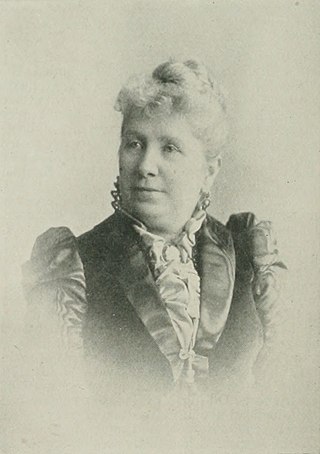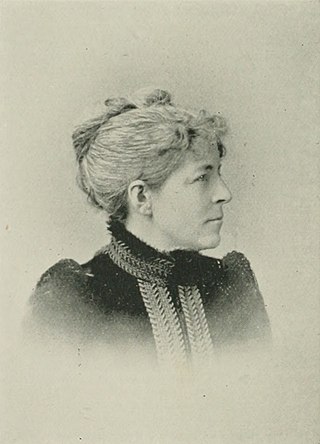
Mary Adaline Edwarda Carter was an American industrial art instructor and designer from the U.S. state of Vermont.

Mary Adaline Edwarda Carter was an American industrial art instructor and designer from the U.S. state of Vermont.
Mary Adaline Elizabeth Carter was born in Hinesburg, Vermont. She was the oldest child of Edward H. and Mary Adaline Kellogg Carter. Her parents were natives of Vermont, descended from the early New England settlers, of English and Scotch origin. Her early education was chiefly from nature and object study. At the age of eight, she attended private and public schools in Burlington, Vermont, and in Vineland, New Jersey, where her family removed in 1866. The years of country life spent in South Jersey during her youth were filled with formative influences that laid a broad and sound basis for her lifework. [1]
Circumstances and environments led Carter to finding occupations for herself, or to having them given her, that promoted inventive and executive powers and stimulated love for science and art. Thirst for larger opportunities and higher education developed, but adversities came, overwork, intense mental strain, then long and severe illness. After health was restored, she was by degrees led to industrial art as her vocation. Though beset by obstacles that would have turned aside one of less resoluteness, her course was progressive and largely successful. With simply the intention of becoming proficient as a teacher of drawing, she entered the Woman's Art School, Cooper Union, New York City. [1]
After graduating with highest honors, in 1876, her services were immediately required as a designer for embroidery. While thus engaged, part of her time was still devoted to art study, and throughout her years of working, she was a constant student in art and other educational subjects. [1]
In the Centennial Exhibition, in 1876, she made a special study of the needlework, art embroideries and textiles of all countries. Not long after, her watercolor studies from nature attracted the notice of John Bennett (1840-1907), the English painter of art-pottery, and she became his pupil and assistant. In 1879, a number of pieces of faience decorated by her were sent by invitation to the exhibition of Howell James & Co., London, England. One of her vases was presented to Sir Frederic Leighton, president of the Royal Academy, and others were sold to art museums in England, to be kept as examples of American art pottery. The same year, some of her work in faience was shown in New York, and won much praise. [1]
When the Associated Artists began their united enterprise which did much in revolutionizing and elevating household taste and interior decoration of American home and public buildings, Carter's services were secured by Louis Tiffany, and she was connected with them several years. At first having to do with all the kinds of work undertaken, glass, mosaics, metals, wood, embroideries, hangings, wall and ceiling coverings, painting or anything else decoratively used in buildings, she was the first woman thus employed. Later, having developed marked ability in plastic art, she had special charge of their pottery and modeling department. Her ornamental relief-work, panels and friezes were often used with heads and figures by Augustus Saint-Gaudens, and combined with work by Charles Caryl Coleman, Maitland Armstrong and other well known artists in the decoration of public and private buildings in New York and different parts of the country. Her designs for memorial and other windows, for decoration of interiors and for different purposes were used in churches and homes, on both east and west coasts. [1]
Frequently, artists, draughtsmen, teachers and others sought instruction from her in special subjects. At different times, she taught classes of children in drawing, and in the Woman's Art School one in porcelain painting. Since 1886, she was instructor of the free classes in clay-modeling, applied design and normal training in form-study and drawing for the Young Women's Christian Association of New York. The courses of study in those classes and all accessories were planned and carried out by her. [1]
From about 1880, Carter resided with her family in the upper suburban part of New York City. She was a staunch member of the Woman's Christian Temperance Union. [1]

Alice Cordelia Morse was an American designer of book covers in the late 19th and early 20th centuries. Her work was inspired by the Arts and Crafts Movement, and she is often placed as one of the top three book designers of her day.

Kate Parker Scott Boyd was a 19th-century American artist, journalist, and temperance worker from the U.S. state of New York. She won a number of medals and prizes in the Centennial Exposition of 1876.

Mary Rogers Gregory was a 19th-century American artist from Florida, specializing in portraiture. She painted portraits of Benjamin Harvey Hill, Judge James M. Jackson, Henry W. Grady, Mary Edwards Bryan, Alexander H. Stephens, and Herschel Vespasian Johnson. Several of her paintings were displayed in the art department of the Cotton States and International Exposition.

Sara Miranda Maxson Cobb was a 19th-century American art teacher, artist, and writer from the U.S. state of New York. She served as director of the Art School of the Maine Wesleyan Seminary and Female College at Kents Hill, Maine, and taught drawing at Colorado State University.

Hannah Johnson Carter was a 19th-century American art educator from the U.S. state of Maine. She served as chair of form and drawing in the College for the Training of Teachers, president of the art department of the National Education Association, and director of the art department in the Drexel Institute of Art, Science and Industry.

Blanche Annie Dillaye was a 19th-century artist from the U.S. state of New York. After studying at the Pennsylvania Academy of Fine Arts, she became one of the significant figures in the American etching revival movement. She acquired prominence in one of the most difficult of arts, and was accepted in some respects as an authority in a field where far more men than women were in competition.

Alice Heighes Donlevy was a 19th-century British-born American artist and writer on art who specialized in wood engraving and illumination. She served as the art editor of Demorest's Magazine.

Anna Cheney Edwards was a 19th-century American educator from the U.S. state of Massachusetts. She served as Associate Principal of Mount Holyoke Seminary, 1872–1888; and as Professor of Theism and Christian Evidences, 1888–1890.

Rebecca Ann Naylor Hazard was a 19th-century American philanthropist, suffragist, reformer, and writer from the U.S. state of Ohio. With a few other women, she formed the Woman Suffrage Association of Missouri and an Industrial Home for Girls in St. Louis. She organized a society known as the Freedmen's Aid Society, and served as president of the American Woman Suffrage Association.

Lady Mary Alice Seymour was a 19th-century American musician, author, elocutionist, and critic. She was referred to as "Octavia Hensel" in the music world, where she was an internationally-known music critic. As a critic, Seymour was renowned. Her musical nature, her superior education, her thorough knowledge of the laws of theory and familiarity with the works of the great composers of the classic, romantic and Wagnerian schools, and the later schools of harmony, gave her a point of vantage above the ordinary. She was one of the original staff writers on the Musical Courier, having been its correspondent from Vienna and other European centers. Seymour played the piano, harp, guitar and organ, but never appeared on the stage, except for charitable events, as her relatives were opposed to her pursuing a professional life. A "confirmed bluestocking", Seymour was also a polyglot who spoke seven languages fluently: German, French, Spanish, Italian, Portuguese, Romanian, and Hungarian dialects. She died in 1897.

Helen M. Winslow was an American editor, author, publisher, and journalist. She began her work on Boston papers. Winslow served as dramatic editor on The Beacon, 1891–97; editor, Woman's Club Department, Boston Transcript, 1893–98; editor, Woman's Club Department of the Delineator, 1897, and again 1912; editor and publisher, The Club Woman, 1897-1904; and she was the publisher of the Official Register of Women's Clubs in America from 1897. She was the author of Salome Sheppard, Reformer. 1893; Concerning Cats, 1900; Concerning Polly, 1902; Literary Boston or To-day, 1902; The Woman of To-morrow, 1905; The President of Quex, 1906; Peggy at Spinster Farm, 1908; A Woman for Mayor, 1910; The Pleasuring of Susan Smith, 1912; and At the Sign of the Town Pump, 1913. She collaborated with Frances Willard in Occupations for Women, and with Marie Wright in Picturesque Mexico.

Hester M. Poole was an American writer, poet, art critic, artist, and an advocate for women's rights.

Mary Foot Seymour was a 19th-century American businesswoman and journalist. In 1879, in New York City, she started the Union School of Stenography, the first women's secretarial school in the United States. She also published a magazine devoted to the interest of women. Seymour served as president of the Union Stenographic and Typewriting Association, commissioner of the United States Court of Claims, commissioner of deeds of New Jersey, and notary public of New York County, New York. She served three different terms in as many offices, and handled a large proportion of the writing done for the United States Patent and Trademark Office. Though she preferred journalistic work, she carried on her stenographic establishment as it paid better than correspondence or reporting. She was a member of the Woman's Press Club of New York City and Sorosis. Seymour died in 1893.

Edna Chaffee Noble was an American elocutionist. She was the founder of the Training School of Elocution and English Literature in Detroit, Michigan, and the Chaffee-Noble School of Expression in London, England. She served as president of the Michigan Association of Elocutionists in 1899.

Jennie de la Montagnie Lozier was an American physician. At the age of nineteen, she began to teach, becoming an instructor in languages and literature in Hillsdale College. Returning to New York City in 1872, she married Abraham Witton Lozier, Jr., the son of Clemence Sophia Harned Lozier, who was the founder and dean of the New York Medical College and Hospital for Women. Here, she studied medicine and after receiving her medical degree, became a professor of physiology. She served on the hospital staff for twelve years and retired from professional work in 1890 to devote herself to her domestic, social, and educational interests. She was a delegate to the International Homoeopathic Congress in Paris in 1889 and was president of Sorosis Club from 1891–94.

Louise Hammond Willis Snead was an American artist, writer, and composer. Her art specialized in miniature painting, illustrations, and needlework. She lectured on Persian rugs, wrote articles of various topics under a masculine pseudonym, and even composed a march.

Ella Seaver Owen was an American artist and teacher. For many years, she taught oil, watercolor, and china painting, and was one of the pioneers, outside of New York City, in china firing. Owen was one of the first women admitted to the University of Vermont, and was one of the founders of the Alpha Rho out of which grew Lambda of Kappa Alpha Theta.
Emily Selinger was an American painter of still life and floral, author of travel writing and poetry, and an educator.

Frances Elizabeth Fryatt was an American author and specialist in household applied arts. She served as editor-in-chief of The Lady's World after its establishment in 1886, and was twice elected president of the Ladies' Art Association of New York.

Ellen A. Dayton Blair was an American social reformer and art teacher.